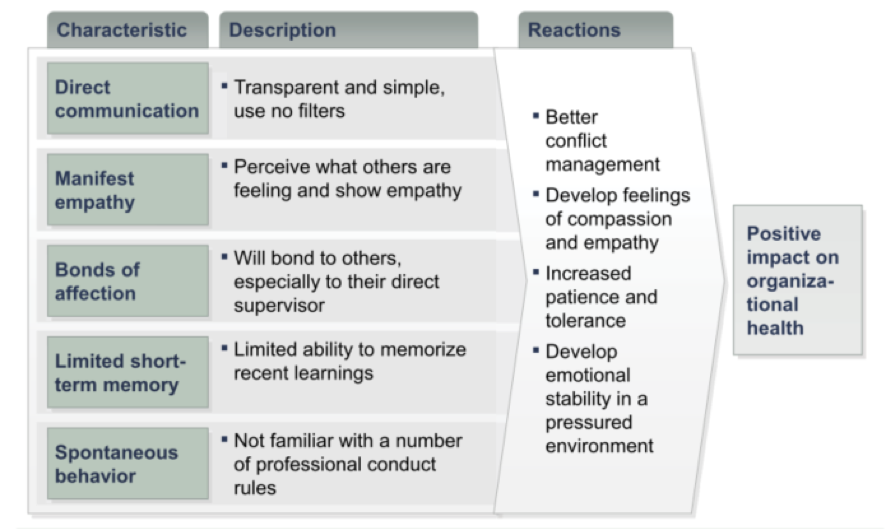
Employment can offer many more advantages to a person with a disability than simply a source of income. “Work gives structure, a sense of purpose, feelings of competency and pride whilst offering an opportunity to learn new things and meet new people. Work can fulfil the need for an individual to be productive, can promote independence, enhance self-esteem, and allow for participation in the mainstream of life.” (Down Syndrome Victoria, 2019).
But, to become employable, it is necessary to develop employment skills.
The main essential and professional employment skills
Employment is a crucial aspect of a youth’s journey towards adulthood. Schools, teachers and families of youth, including youth with disabilities, play a vital role in helping youth explore careers that match their strengths and interests and in helping youth understand the importance of building basic work skills so they are prepared for employment (National Collaborative on Workforce and Disability for Youth, 2012).
In this section we will approach the main work skills needed to succeed in life. The term work skills may seem vague, but it simply refers to basic abilities and habits employers are looking for in their employees (National Collaborative on Workforce and Disability for Youth, 2012). Work skills are a combination of hard skills, the foundational skills that employers desire like reading, writing, and math, and soft skills, the common-sense, everyday skills, like getting along with others, that help youth succeed in all aspects of life (National Collaborative on Workforce and Disability for Youth, 2012).
The Equipped for the Future Framework defined a list of work readiness skills that fall within the following four categories and are recognized as important for developing entry level skills needed across all industry sectors (National Collaborative on Workforce and Disability for Youth, 2012): communication skills, interpersonal skills, decision making skills and lifelong learning skills.
Source: National Collaborative on Workforce and Disability for Youth (2011, 2012)
Employers value employability skills because they are linked to how you get along with coworkers and customers, your job performance, and your career success (Minnesota State Careerwise, 2019). Following the Minnesota State Careerwise (2019), there are two main group of skills that are essential for employability: the essential employability skills and the professional skills.
Professional Skills
The general employability skills above help you to get hired and to keep any job. In addition, anyone who wants to advance in their careers and people working in higher-level jobs should have the following professional skills (Minnesota State Careerwise, 2019).
Online resources
How apprenticeships inclusive of disabled people bridge the gap between skills and employment
“The socio-economic inclusion of persons with disabilities has multiple positive effects. Access to vocational training and employment offers a chance to become financially independent, to contribute to the growth of one’s family and community and to participate in society. It also reduces the need for social benefits and increases the tax basis. Employers also report how recruiting persons with disabilities has been beneficial to their business success because they create more diverse workforces.” (International Labour Organization, 2018, p. 2) .
In Figure 5, the International Labour Organization (2018) how apprenticeships inclusive of disabled people bridge the gap between skills and employment.
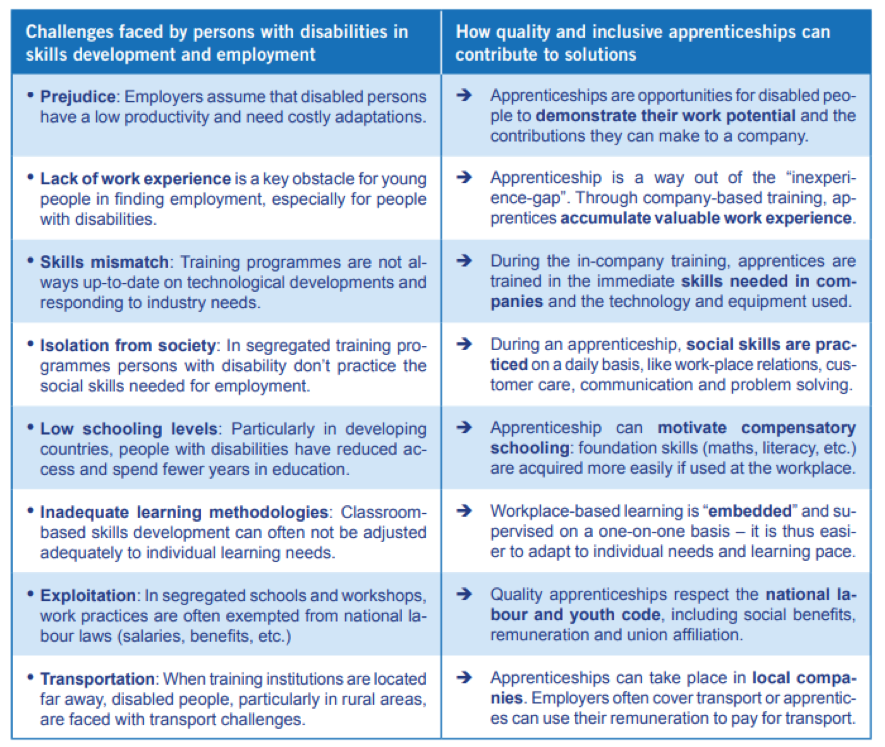
Employment skills for the works of future
As could be read in the European Commission (2019) report intitled The Changing Nature of Work and Skills in the Digital Age, “even if we cannot name the jobs that will appear in the future, we may be in a better position to describe what workers will be doing in these jobs. For instance, as suggested by Wilson et al. (2017), some of the AI-related profiles sought by employers may be” (p. 27) – see:
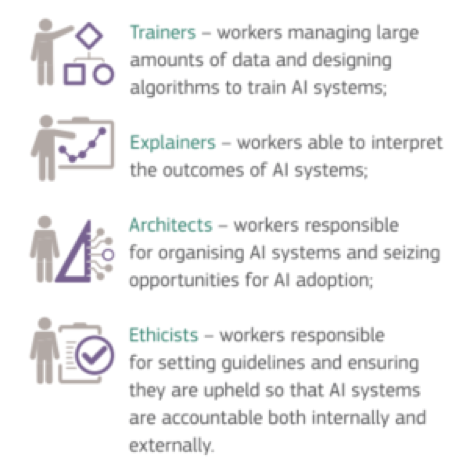
“In the next decade it is expected that technological change will bring about a decline in physical tasks, and an increase in cognitive and social tasks, digital tools, and autonomy and teamwork (Cedefop, 2018). Therefore, digital and non-cognitive skills (…) are likely to be in greater demand.” (European Commission, 2019, p. 29). See the definition of digital skills and non-cognitive skills:
“Digital competence involves the confident, critical and responsible use of, and engagement with, digital technologies for learning, at work, and for participation in society. It includes information and data literacy, communication and collaboration, media literacy, digital content creation (including programming), safety (including digital well-being and competences related to cybersecurity), intellectual property related questions, problem solving and critical thinking.”
Source: European Digital Competence Framework (2018), cited in European Commission (2019, p. 30)
Non-cognitive skills are referred to in the literature in different ways: soft skills, personality traits, character skills, human literacy, 21st century skills, life skills, key competences, or social and emotional skills.
In the empirical research, non-cognitive skills refer among others to: open-mindedness, openness to learn and to change, flexibility, curiosity, innovation, creativity, entrepreneurship, resilience, planning/organisation, responsibility, persistence, teamwork, communication, initiative, sociability, empathy, collaboration, emotional control and positivity.
Non-cognitive skills help individuals to adapt better to the changing work and life environment.
Source: European Commission (2019, p. 31)
“A moderate level of digital skills and strong non-cognitive skills are expected to be requested for most of the jobs of the future” (European Commission, 2019, p. 32).
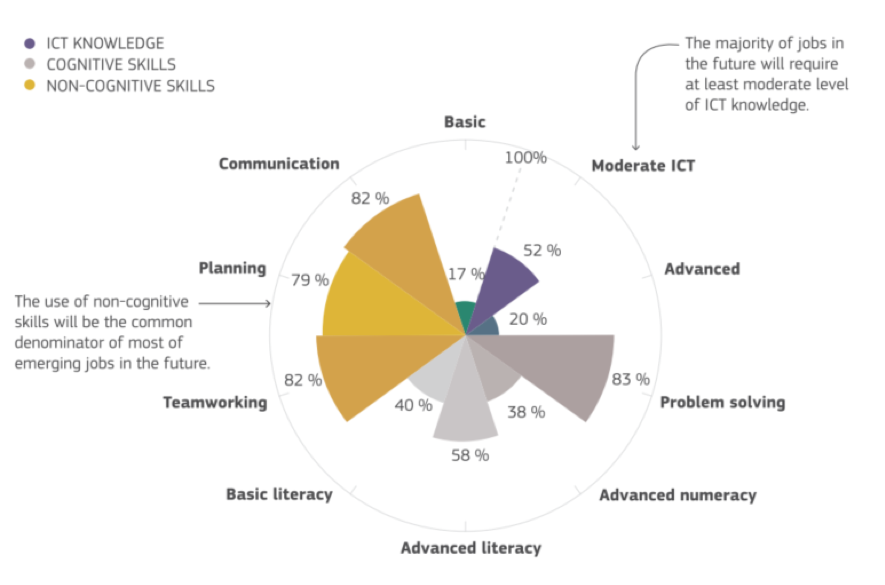
The Skills-OVATE: Skills Online Vacancy Analysis Tool for Europe (Cedefop – European Centre for the Developmnet of Vocational Training, 2019) offers an dynamic dashboard helps visualise emphasis employers put on particular skills in occupations. Considering the 18 countries with information available, Figure 10 shows the most requested skills in Europe (it presents skills sorted by their frequency across all online job vacancies). Be able to adapt to change, work as a team, use a computer and to know English are the four more requested skills.
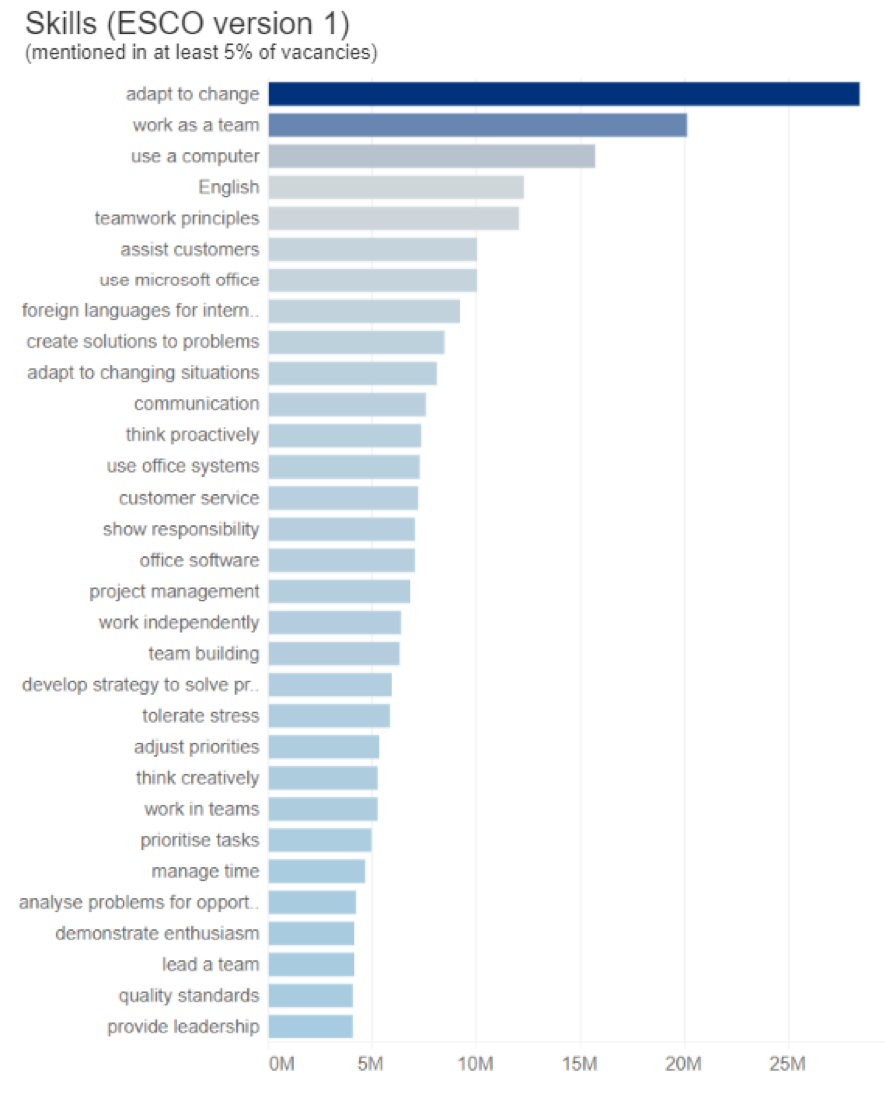
Considering the same study, Figure 11 shows the top 10 occupations in Europe (Cedefop – European Centre for the Developmnet of Vocational Training, 2019), with software developers, shop sales assistants, freight handlers and systems analysts taking the lead.
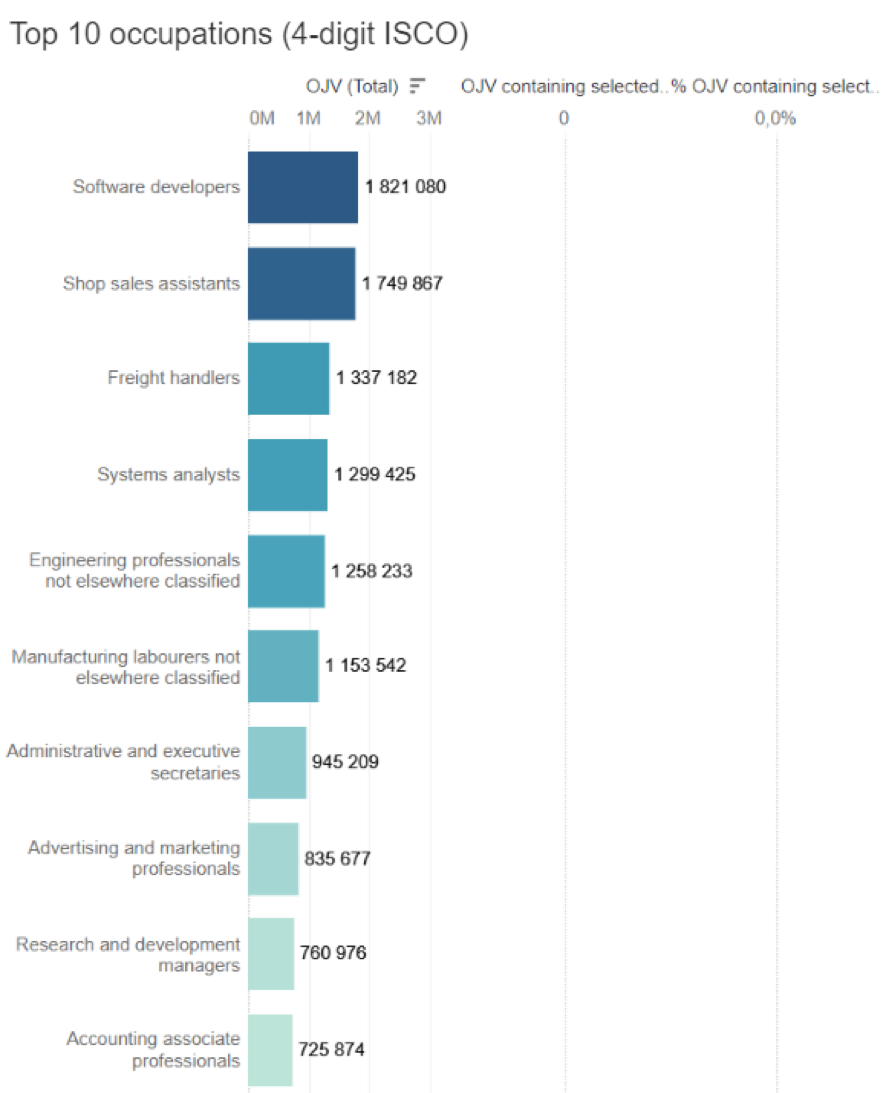
In Video 1 International Labour Organization’s Olga Strietska-Ilina, Senior Skills and Employability Specialist, responds to the question of what skills are needed for the jobs of the future.
Online resources
Resources for employers
Advantages of hiring people with disabilities
“It’s been proven that companies employing people with disabilities reduce costs associated with turnover, training and safety. They also benefit from greater innovation and customer loyalty” (Discover Ability Network, 2019).
Hiring people with disabilities have several advantages for companies. Some examples:
- Positive opportunities to your workforce: “Seeing the ability in a workforce that includes people with Down syndrome or other disabilities can bring positive opportunities to your workforce. Inclusive employment brings a new perspective to the value you invest in staff, what they bring to the job, and how they engage with each other and your customer base” (CDSS, nd, p. 4). “People with disabilities are just like the people in your existing workforce, but they bring with them a strong motivation to achieve at what they do” (CDSS, nd, p. 3).
- Return on investment: “By hiring people with disabilities, a business can access new markets, improve productivity through innovation, reduce hiring and training costs, and increase retention.” (Down Syndrome Association of of Greater St. Louis, 2019)
- Think innovation: “Employees with disabilities bring unique experiences and understanding that transform a workplace and enhance products and services. People with disabilities can help create more efficient and effective business processes, use technology in new ways to increase productivity, and stimulate new product and services development.”(Down Syndrome Association of of Greater St. Louis, 2019)
- Add value to your company: The study of McKinsey & Company (2014) showed that “people with Down Syndrome generally have a positive impact on a number of organizational health dimensions such as leadership, external orientation (a positive impact on client satisfaction), culture & climate, motivation and coordination & control.” (p. 5). In Figure 4 there is a list of some of the characteristics typical of people with Down Syndrome can have a positive impact on organizational health.
- Positive impact on business performance: There is a correlation between organizational health and performance (McKinsey & Company, 2014). “The positive impact people with Down Syndrome can have on “organizational health” also reflects on business performance, as it is known that there is a direct, mapped relationship between increased “organizational health” and business performance. As people with Down Syndrome can affect more than one of the dimensions that make up “organizational health”, they are one of the numerous factors that can influence business performance.” (McKinsey & Company, 2014, p. 5)
- Obey the law. Several countries in the world have specific legislation requiring companies to hire people with disabilities.
- To be socially responsible. There are several ways of a company be socially responsible. Hiring people with disabilities is one of them.
The Down Syndrome Victoria’s employment video (2015) – see Video 2 – is an example that employing someone with Down syndrome it’s good for business.
Online resources
Strategies for effectively integrating people with disabilities in the workplace
Determining an Employee & Employer Match
The National Down Syndrome Society (2016) suggests that a good way to discover the best match between a disabled person (namely the ones with Down syndrome) and the employer is to twofold. First, to provide a priori strategies to select the individual and integrating them on the job. Second, during the job to implement good practices that influence the success of companies when working with disabled person. Both topics are being presented below.
A priori strategies to select the individual and integrating them on the job
The National Down Syndrome Society (2016) suggest three strategies to select and integrate a disabled person (namely the ones with Down syndrome) on a job:
Interviewing and assessment
Make sure that the company have accommodations adequate for the interviewing process. If your facilities are not accessible, think in solutions as holding the interview in an alternative location.
The format of the interview may have to be adapted (The Conference Board of Canada, 2015). “Employers should focus on the job at hand and whether the individual can complete that job. Variables that may interfere in the selection of people with disabilities include focusing on experience rather than abilities (as people with disabilities have less access to employment than the general population). (The Conference Board of Canada, 2015, p. 44).
The checklist provided in Table 1 can be useful in the interviewing assessment.
Table 1 – Accessible Interviewing Checklist
In the process of interviewing, the companies can the following guidelines to support the process of hiring the best and most diverse workforce possible (The Conference Board of Canada, 2015, pp. 126-127):
Online resources:
Several tools and templates to be used in the process of recruitment, selection, accommodation process, job task analysis form, between others are available at:



Good practices that influence the success of companies when working with disabled person
There are good practices that improve the success of integrating people with disabilities in the companies. In the area of Down Syndrome, the best practices are:
Online Resources


Practical strategies to support learning in the workplace
Following the Down Syndrome Australia (2018) this section contains examples of practical strategies that have been developed to support people with Down syndrome. “Some employees may have difficulty with attention, memory and information processing. However, simple strategies and visual aids will help with carrying out their roles” (Down Syndrome Australia, 2018, p. 6). The principal practical strategies are (Down Syndrome Australia, 2018):
Tips for interacting with individuals with disabilities
The Conference Board of Canada (2015) give tips for companies to use interacting with individuals with disabilities. The main recommendation is to put people first. “When interacting with people with disabilities, employers should focus on the person first rather than the disability.” (p. 43). Additionally, the language used should emphasize the individual rather than the disability. For example, instead of referring to an “autistic person,” the more appropriate terminology is “a person with autism” (The Conference Board of Canada, 2015).
Below are some specific tips for interacting with people with disabilities (The Conference Board of Canada, 2015):
- Any disability – It is appropriate to offer assistance when it appears that an individual with a disability needs it, but wait until the offer is accepted before assisting him.
- Physical disabilities – Place yourself at the person’s eye level when possible. Do not touch the individual’s wheelchair or other assistive device, as this is part of her personal space.
- Vision loss – Identify yourself at the beginning of a conversation and announce when you are leaving.
- Hearing loss – To get the attention of an individual with hearing loss, tap gently on his shoulder or arm. Look directly at the individual and speak clearly and at a normal volume. keep your hands away from your face when speaking and use short sentences. If the individual uses a sign-language interpreter, speak directly to the individual, not the interpreter.
For more details about disability etiquette see (online resource):
Video resources for employers
In this section there are available several links for short video lessons that can be used by employers to hire people with disability. Most of them were made available by Austrilian Government & Job Access (2018):
- Disability employment basics: https://www.jobaccess.gov.au/employers/employer-toolkit/disability-employment-basics/
- Fundamentals for organisations: https://www.jobaccess.gov.au/employers/employer-toolkit/fundamentals-for-organisations/
- Recruiting people with disability: https://www.jobaccess.gov.au/employers/employer-toolkit/recruiting-people-with-disability/
- Getting your workplace ready: https://www.jobaccess.gov.au/employers/employer-toolkit/getting-your-workplace-ready/
- Managing your team: https://www.jobaccess.gov.au/employers/employer-toolkit/managing-your-team/
© 2021, StartingUp4Inclusion. All Rights Reserved.







